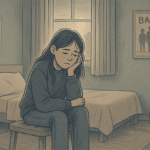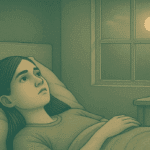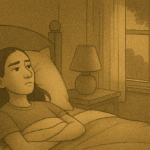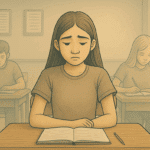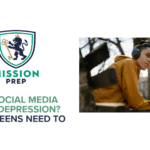Nature-Based Mental Health Treatment: Horticultural Therapy for Anxiety & Depression

But before we begin, let’s get one thing straight: Gardening for anxiety relief or depression isn’t a therapy replacement. But it can offer a different, complementary, kind of help. One that offers grounding and stress relief in its very nature.3
Horticultural therapy, for example, uses gardening as a therapeutic tool. There’s growing evidence that being around plants and carrying out horticultural tasks, such as watering and touching soil, can reduce negative thought spirals and help us focus.2 What’s more, it can reduce the effects of anxiety and depression.
This guide explores the following aspects of horticultural therapy for teens:
What horticultural therapy for teens is- Types of activities involved in horticultural therapy
- How gardening helps anxiety and depression in teens
- Types of teen nature healing programs
- How Mission Prep can help with teen nature healing programs

What Is Horticultural Therapy?
Horticultural therapy is an evidence-informed method of using plant care and garden environments to improve mental health, especially in teens facing anxiety, depression, or stress-related conditions.
Horticultural therapy is grounded in biophilia theory, which suggests humans are biologically wired to seek connection with nature. Unlike recreational gardening, horticultural therapy follows a clear therapeutic framework. Sessions are guided by trained facilitators who choose specific mental health gardening activities based on a teen’s needs. This might involve planting from seed to practice patience, pruning to manage frustration, or sitting in a sensory-rich space to calm the nervous system.
Some other horticultural and mental health gardening activities include
- Scented plant gardening: Scented plants like mint and lavender contain chemicals in their aroma that soothes our nervous system. Roses, for example, contain 400 different molecules in their scent, some of which have a relaxing effect on us.
- Watering routines: Plants require a strict watering schedule. As such, watering routines can help to teach responsibility and can become a source of purpose.
- Raised bed or container gardening: Gardening at home doesn’t require a lot of space, so containers make it more accessible for smaller or indoor spaces.
- Harvesting and preparing food: Reinforcing nourishment and self-worth through the act of receiving care for items grown.
- Designing or decorating garden spaces: Offering creative expression and personalization, which can be especially helpful in group settings.
How Gardening Helps Anxiety and Depression in Teens
Teens experiencing chronic anxiety or depression often live in a state of nervous system dysregulation.⁴ Their bodies may be flooded with cortisol, their minds overwhelmed by racing thoughts, or their energy levels flattened by emotional fatigue. Gardening offers a unique path to recovery that works through a combination of behavior and biology.
Emerging research shows that nature-based activities can help rebalance the autonomic nervous system.⁵ In other words, when teens garden, they can gently reach a state of calm through breath, movement, and tactile contact. Their bodies shift out of “fight or flight” and into a parasympathetic state, where rest, digestion, and healing can take place.
Beyond nervous system regulation, plant care also affects the brain’s reward and motivation circuitry. Repetitive, hands-on tasks like digging or pruning activate the prefrontal cortex and boost dopamine, a neurotransmitter that supports attention, pleasure, and goal-setting – and is often depleted in teens with depression.⁶ In fact, just 20 minutes of outdoor activity has been shown to lower cortisol levels and rumination, as well as increase mood stability.⁷
Gardening can also be especially healing for trauma. For many teens, especially those with complex emotional histories, traditional therapy can feel confrontational. Gardening offers an alternative approach as it’s non-verbal, sensory-rich, and symbolically safe.
Types of Teen Nature Healing Programs
Horticultural therapy is adaptable. Some teens benefit from structured sessions at residential treatment centers, while others thrive with hands-on activities in school gardens or even at home. Whether guided by a licensed therapist or supported by a mentor, these programs use nature intentionally to ease symptoms of anxiety and depression. The setting can be flexible, but the goals of regulation, reflection, and reconnection remain the same.
There are several types of teen nature healing programs, including:
Home-Based Therapeutic Gardening
Some teens aren’t ready for group gardening settings early in recovery. But caring for a few potted herbs on a windowsill or planting lettuce in a raised bed outside can still offer therapeutic value. It’s quiet, private, and can be done on their own time. Many teens naturally pair this kind of gardening with journaling – writing down what’s growing, what’s not, and how they’re feeling. Even small interactions with plants have been shown to reduce stress responses in the body. And when those moments are reflected on, a shift can happen.⁸ Teens start to notice patterns in their mood, building awareness without needing to explain it to anyone else.
Group Gardening Activities
Research shows that collaborative horticultural therapy can significantly reduce loneliness and increase prosocial behavior among youth with mood disorders.⁹ There’s something disarming about working quietly alongside someone, hands in the soil, pulling weeds or digging holes. In group gardening settings, whether at school or in a residential program, this kind of side-by-side rhythm builds connection without forcing it. Shared tasks turn into shared wins. Teens learn how to rely on each other, offer help, accept it in return, and sometimes just coexist peacefully.
These aren’t just feel-good moments. They’re small but steady shifts in how teens relate to others – and to themselves.
Therapeutic Gardens in Clinical Settings
Studies show that access to green spaces supports brain development in children and adolescents.¹⁰ For this reason, some treatment centers integrate professionally designed therapeutic gardens into their mental health programs. Some of the main elements typically included are sensory paths and medicinal herb beds, as these provide both physical and mental health benefits. Meandering paths and water features can also give a sense of slowness and mindfulness, which can support mental health.
Trained horticultural therapists lead activities that weave together gardening tasks with treatment plans targeting specific conditions, such as depression, anxiety, or trauma.
Outdoor Therapy Sessions
Some programs don’t just bring therapy outdoors. They let nature become part of the process. Instead of sitting across from a therapist under fluorescent lights, teens might talk while walking in or observing nature. The sights and sounds of birds calling, wind moving leaves, and the smell of earth do more than set the mood. They shift the body out of fight-or-flight, reducing cortisol and allowing the nervous system to soften.
For many teens who find traditional office settings too intense or sterile, being outside helps the hard stuff feel a little easier to say. Outdoor therapy can help teens stay more grounded during emotionally difficult conversations and improves treatment outcomes for anxiety and depression.¹¹
Nature Immersion Workshops
Research on nature immersion for youth suggests it increases emotional resilience and strengthens the stress-buffering capacity of the nervous system.¹² Nature workshops blend gardening with nature-based creative therapies like eco-art, seed-to-harvest projects, or guided nature walks. Instead of focusing directly on verbal processing, which can sometimes feel daunting, these immersive experiences support emotional regulation and self-expression through hands-on engagement. For teens who struggle with talk therapy, this model creates therapeutic entry points through experience rather than explanation.

Contact Mission Prep for Teen Nature Healing Programs
When anxiety or depression makes everyday life feel overwhelming, talk therapy might not be the right fit. At Mission Prep, we believe healing can also happen with hands in the soil, under open skies, and surrounded by living things that grow at their own pace.
Our nature-based mental health programs for teens offer more than just outdoor time. They create a structured, evidence-based environment where therapeutic gardening becomes a path toward emotional regulation, self-trust, and calm. Whether your teen is struggling with mood disorders, stress, trauma, or emotional overwhelm, our horticultural therapy model offers a safe space to reconnect with nature, others, and themselves.
Each of our programs is led by licensed mental health professionals and integrates garden-based healing activities such as seed planting, compost building, and mindfulness in sensory-rich spaces.
If you’re interested in learning more about horticultural therapy for depression or stress reduction through gardening, we’re here to help. Reach out to Mission Prep – we can talk you through whether our nature healing programs are the right fit for your teen’s treatment journey.
References
- National Institutes of Health (US), & Biological Sciences Curriculum Study. (2007). Information about mental illness and the brain. National Institutes of Health. https://www.ncbi.nlm.nih.gov/books/NBK20369/
- Azad, S., & Marselle, M. (2025). Thriving through stressful life events with nature: A mixed-method study on tending indoor plants and rumination resilience. International Journal of Environmental Research and Public Health, 22(3), 369. https://pmc.ncbi.nlm.nih.gov/articles/PMC11942186/
- Oh, Y.-A., Lee, A.-Y., An, K. J., & Park, S.-A. (2020). Horticultural therapy program for improving emotional well-being of elementary school students: An observational study. Urban Forestry & Urban Greening, 51, 126670. https://www.researchgate.net/publication/338706532_Horticultural_therapy_program_for_improving_emotional_well-being_of_elementary_school_students_an_observational_study
- Paulus, F. W., Ohmann, S., Möhler, E., Plener, P. L., & Popow, C. (2021). Emotional dysregulation in children and adolescents with psychiatric disorders: A narrative review. Frontiers in Psychiatry, 12, 628252. https://pmc.ncbi.nlm.nih.gov/articles/PMC8573252/
- Gladwell, V. F., Brown, D. K., Barton, J. L., Tarvainen, M. P., Kuoppa, P., Pretty, J., Suddaby, J. M., & Sandercock, G. R. H. (2012). The effects of views of nature on autonomic control. European Journal of Applied Physiology, 112(9), 3379–3386. https://pubmed.ncbi.nlm.nih.gov/22270487/
- Lee, A.-Y., Kim, S.-O., & Park, S.-A. (2021). Attention and emotional states during horticultural activities of adults in their 20s using electroencephalography: A pilot study. Sustainability, 13(23), 12968. https://www.mdpi.com/2071-1050/13/23/12968
- Frontiers Science Communications. (2019, April 9). Stressed? Take a 20-minute nature pill. Frontiers. https://www.frontiersin.org/news/2019/04/09/20-minute-nature-pill-relieves-stress/
- Lee, M.-S., Lee, J., Park, B.-J., & Miyazaki, Y. (2015). Interaction with indoor plants may reduce psychological and physiological stress by suppressing autonomic nervous system activity in young adults: A randomized crossover study. Journal of Physiological Anthropology, 34(1), 21. https://pmc.ncbi.nlm.nih.gov/articles/PMC4419447/
- Wood, C. J., Barton, J., & Wicks, C. L. (2024). Effectiveness of social and therapeutic horticulture for reducing symptoms of depression and anxiety: A systematic review and meta-analysis. Frontiers in Psychiatry, 15, 1507354. https://pmc.ncbi.nlm.nih.gov/articles/PMC11799672/
- Li, Q., Whittle, S., & Rakesh, D. (2025). Longitudinal associations between greenspace exposure, structural brain development, and mental health and academic performance during early adolescence. Biological Psychiatry. https://pubmed.ncbi.nlm.nih.gov/40222467/
- Coventry, P. A., Brown, J. E., Pervin, J., Brabyn, S., Pateman, R., Breedvelt, J., Gilbody, S., Stancliffe, R., McEachan, R., & White, P. L. (2021). Nature-based outdoor activities for mental and physical health: Systematic review and meta-analysis. SSM – Population Health, 16, 100934. https://pmc.ncbi.nlm.nih.gov/articles/PMC8498096/
- Liu, J., & Green, R. J. (2023). The effect of exposure to nature on children’s psychological well-being: A systematic review of the literature. Urban Forestry & Urban Greening, 81, 127846. https://www.sciencedirect.com/science/article/pii/S1618866723000171


